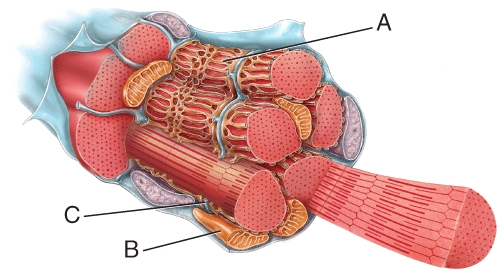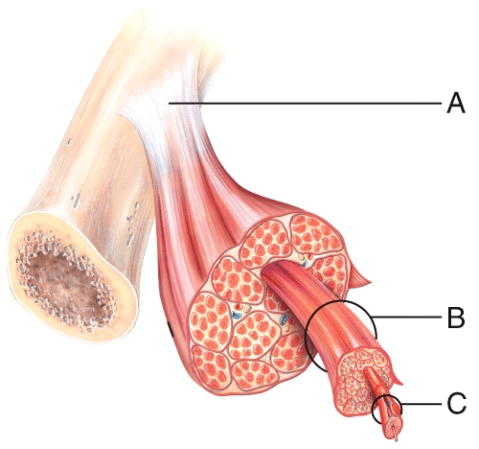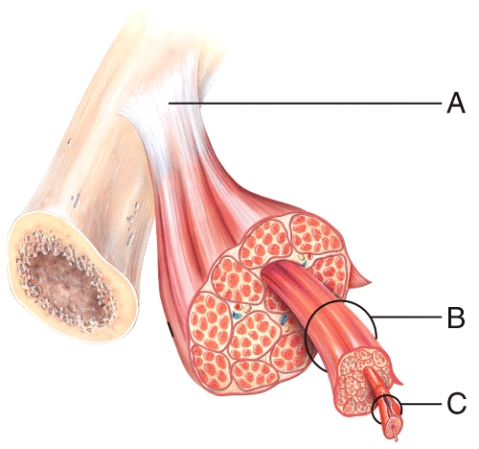B) False
Correct Answer

verified
Correct Answer
verified
Multiple Choice
_____ muscle fibers (cells) do NOT contain sarcomeres.
A) Smooth
B) Cardiac
C) Skeletal
D) Smooth and cardiac
F) None of the above
Correct Answer

verified
Correct Answer
verified
Multiple Choice
Match the connective tissue components of skeletal muscle with the tissues. Identify the description that matches fast glycolytic fibers.
A) adapted for intense movements of short duration, such as weight lifting
B) adapted for maintaining posture and endurance-type activities
D) undefined
Correct Answer

verified
Correct Answer
verified
Multiple Choice
Match the connective tissue components of smooth muscle with the tissues. Identify the characteristic of smooth muscle tissue.
A) no transverse tubules
B) no muscle tone
D) undefined
Correct Answer

verified
Correct Answer
verified
Essay
List four functions of muscle tissue and in one sentence for each function, elaborate on the function or give an example to illustrate the function.
Correct Answer

verified
1. Producing body movements: movement of...View Answer
Show Answer
Correct Answer
verified
View Answer
Multiple Choice
Identify features of this muscle fiber (cell) structure labeled C. 
A) invagination of the sarcolemma
B) open to the outside of the cell
C) muscle action potentials are able to propagate through
D) All of the choices are features
F) All of the above
Correct Answer

verified
Correct Answer
verified
Multiple Choice
Identify this organelle of the muscle fiber (cell) labeled B. 
A) myofibril
B) sarcoplasmic reticulum
C) nucleus
D) mitochondrion
F) All of the above
Correct Answer

verified
Correct Answer
verified
Multiple Choice
Match the connective tissue components of skeletal muscle with the tissues. Identify the description of a synaptic vesicle.
A) membrane-enclosed sac that stores neurotransmitter
B) a small space that separates the cell membrane of a motor neuron from the sarcolemma of a skeletal muscle cell
D) undefined
Correct Answer

verified
Correct Answer
verified
True/False
The darker area in a sarcomere is called the I band.
B) False
Correct Answer

verified
Correct Answer
verified
Multiple Choice
The connective tissue that surrounds and separates individual skeletal muscle fibers (cells) is called _____.
A) sarcolemma
B) fascia
C) endomysium
D) epimysium
F) All of the above
Correct Answer

verified
Correct Answer
verified
Multiple Choice
Strength training has a positive impact on the body by
A) increasing bone strength.
B) raising resting metabolic rate.
C) reducing feelings of stress and fatigue.
D) all of these answers are correct.
F) B) and C)
Correct Answer

verified
Correct Answer
verified
True/False
A somatic motor neuron together with all the skeletal muscle fibers (cells) it stimulates is called a motor unit.
B) False
Correct Answer

verified
True
Correct Answer
verified
Multiple Choice
Compared to skeletal muscle, cardiac muscle differs in that it:
A) contracts for shorter periods of time.
B) has a short refractory period.
C) has a different arrangement of thick and thin filaments.
D) has branching cells.
F) A) and B)
Correct Answer

verified
Correct Answer
verified
Multiple Choice
Body building increases the size and strength of which type of muscle fiber?
A) slow oxidative fibers
B) fast oxidative glycolytic fibers
C) fast glycolytic fibers
E) A) and C)
Correct Answer

verified
C
Correct Answer
verified
Multiple Choice
Which is a correct statement?
A) A muscle fiber (cell) contains myofibrils.
B) A myofibril contains thick and thin filaments.
C) Thick and thin filaments are arranged into sarcomeres.
D) All of the choices are correct.
F) None of the above
Correct Answer

verified
Correct Answer
verified
True/False
The contractile elements of skeletal muscle fibers (cells) are myofibrils.
B) False
Correct Answer

verified
Correct Answer
verified
Multiple Choice
The connective tissue covering this structure labeled C is the 
A) sarcolemma
B) endomysium
C) perimysium
D) epimysium
F) None of the above
Correct Answer

verified
B
Correct Answer
verified
Multiple Choice
For contraction of a muscle to being, what event must occur at the sarcolemma?
A) blockage of reuptake channels
B) exocytosis of vesicles storing neurotransmitters
C) intracellular calcium levels increase after potassium entry
D) acetylcholine binding and opening of sodium channels
F) None of the above
Correct Answer

verified
Correct Answer
verified
Multiple Choice
The connective tissue covering this structure labeled B is the 
A) sarcolemma
B) endomysium
C) perimysium
D) epimysium
F) A) and B)
Correct Answer

verified
Correct Answer
verified
Multiple Choice
In skeletal muscle, the sarcoplasmic reticulum (SR) :
A) forms transverse (T) tubules.
B) is similar to the Golgi complex.
C) contains extracellular fluid.
D) releases Ca2+ to trigger contraction.
F) B) and D)
Correct Answer

verified
Correct Answer
verified
Showing 1 - 20 of 75
Related Exams